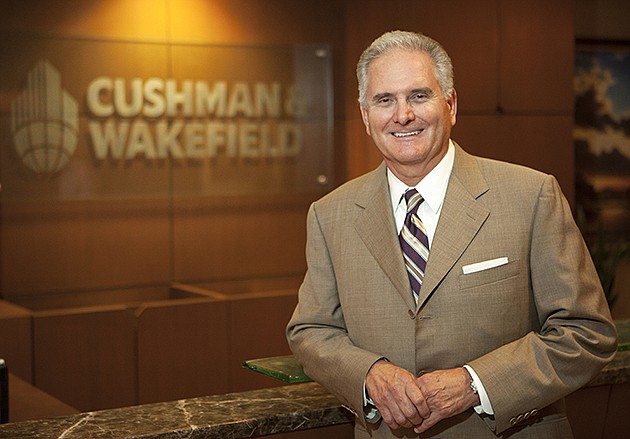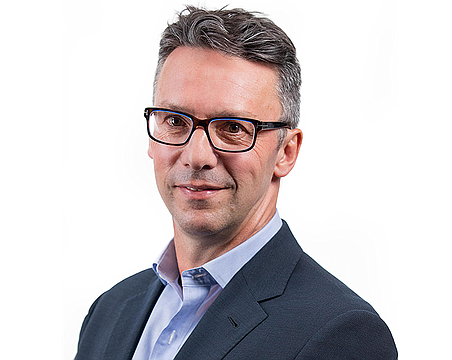As the new Florida market leader for Cushman & Wakefield, Larry Richey oversees six corporate offices and one affiliate office sprinkled through out the state.
Sure, it's a lot of responsibility, but the new gig isn't too different for 57-year-old Richey, who has led the Tampa, Orlando and Jacksonville offices for the last 23 years for the company and spent 10 years in Atlanta with the company prior to that. It just means a little more time on the road, he says.
In 2014, Richey expects his corporate offices in Tampa, Orlando, Jacksonville, Miami, Fort Lauderdale and Palm Beach, and his affiliate office in Fort Myers, to exceed the $3 billion mark. They're already well on track, he says. Richey is also looking to grow the Florida offices, which currently include 107 brokers and 279 professionals.
Richey spoke with the Business Observer at his office in Tampa City Center about his new role and expectations for Florida's commercial real estate market. Here's an edited transcript of the interview:
What's your first priority with the new title?
I want to grow bigger, especially in South Florida. It's an incredible area — with Dade, Broward County, and Palm Beach. Looking at metrics, the area makes up almost half the state in terms of population and aggregate space. It's so urban and populated that it represents about 50% of the opportunity in Florida. I want to take advantage of that. We're the No. 1 or No. 2 firm in almost every market in Florida, and I think we have the opportunity to be that in South Florida. We'll add new clients and we'll add professionals to our three offices.
How will you change the South Florida offices?
We expect to increase our brokerage presence in South Florida by at least 50% in the next two to three years. In the three offices in central and north Florida, we have 54 brokers. We have 32 brokers in South Florida, 39 with Fort Myers. We should be similar in size for the two areas, which is an aggressive growth goal.
Why take a new approach?
There's a real change in the firm. We're a 100-year-old firm with a great brand. Now we have three, arguably four, generations working in our offices. Understanding that to be successful over the next decades, we need to appreciate the value of millennials and their expectations for the business and culture. It's our mission to make Cushman & Wakefield the coolest place to work if you are a real estate professional or broker.
How have things changed?
The client comes first. Satisfied clients help get more clients. Team comes second, individual comes third.
It was a Wild West gun-slinging business in the past. It was individually siloed, and didn't always benefit the clients. It's changing in the industry as a whole, but happening at a faster rate at our firm. It's less bureaucratic and management-heavy. The communication is better with a single source leadership team over a bigger market.
What trends are you seeing in Florida commercial real estate?
It will be better for Florida if we build out dense urban environments. We can't keep building suburbs and shopping centers.
It's starting to happen all along the coast in Florida — downtown St. Pete, Tampa, Jacksonville, Fort Lauderdale. It's just a fraction of what we're going to see in terms of urbanization. Urbanization is the movement of individuals and companies to the urban core. It will happen at a faster rate.
What's hindering urbanization in Florida?
The main obstacle is the lack of transportation and transit options, like bus, high occupancy highway systems and ultimately rail. But it is gratifying to watch the conversation go from “We can't afford it” four years ago, to “We can't afford not to do so.”
Orlando has seen a huge benefit from the Sunrail in attracting talent and adding jobs from a commuter rail. The rail in South Florida needs to be expanded. Orlando needs to be expanded. Tampa needs to catch up.
Atlanta's Marta system built in the '70s and '80s fed dollars to the city. Lots of Fortune 500 companies are headquartered in Atlanta. You can look at the Bart in San Francisco and the Metro in (Washington,) D.C. as other examples.
What other trends are you watching in Florida, in addition to the urbanization trend?
What's going to happen to industry and manufacturing in Florida. The impact of ports and global supply chains like expanding the Panama Canal. There's a school of thought in Florida that manufacturing and distribution will become a mega market in the central part of the state. In Southern California, the L.A. and Long Beach ports grew one of the top industrial markets, the Inland Empire.
Imagine a changed world, where you can go through the canal directly to Florida, Miami or one of the other 10 ports. It will be faster and less money for our South and Central American trading partners. The Inland Empire was vacant land — it's the same in Central Florida, other than agriculture, Orlando, Ocala and The Villages and the University of Florida.
The Florida ports also have a direct line to Africa. Twenty years from now, there will be a lot more in the state. The move to distribution and manufacturing is the biggest trend in Florida.
How do you think companies like Amazon and USAA moving to Tampa will impact the commercial real estate market?
Success breeds success. And companies watch other companies. One of the most important factors is the proximity to current customers in Tampa, Orlando, and the East Coast. Florida is soon to be the third most populous state. With household names or big brands like USAA and JP Morgan building regional headquarters or shared services locations, it's getting the attention of other companies. The relocation consultant is recommending our city or our state. That's a positive checkmark. Getting attention of prospects is the hard part. Companies pay attention when others succeed, especially with competitors. It's a snowball effect and I think we're on a roll. We have excellent EDO's (economic development organizations), and we have to get the word out.
What do you think Florida needs to do to continue to attract companies?
Florida doesn't come close to the incentives of most states and we continue to outperform every state other than Texas. We have to do this to compete or we'll lose our current employers. It's understanding how important this is, and we need more of it. The return on investment will be tremendous.
Attracting Young Talent
The biggest challenge at Cushman & Wakefield is “finding and keeping the best talent,” Richey admits. “We're known for tenure and we want to create a culture where people want to stay here for their entire career.” But the first step is recruiting that talent. Richey says he's looking for revenue producers and others — from senior brokers to mid-level to young people. Here are a few of the ways he hopes to attract the next generation:
Redesign of offices
Ask colleagues in 30s and 40s to become involved in recruiting the next generation.
Use successful young talent to attract more young talent. “We hired former professional soccer player Scott Garlick in Tampa. He's a great producer and leader in the brokerage community.”
Florida as a whole needs to work on bringing back the younger generations, Richey says. Groups such as the Tampa Downtown Partnership and Friends of the Riverwalk are helping build up the downtown markets, activate the parks and attract young, urban dwellers. He joked that our “goal was to bring our children back home; all my kids are back now,” Richey says.






